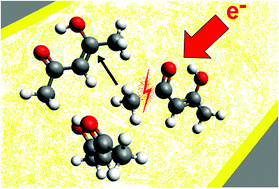Acetone and the precursor ligand acetylacetone: distinctly different electron beam induced decomposition?†
Abstract
In focused electron beam induced deposition (FEBID) acetylacetone plays a role as a ligand in metal acetylacetonate complexes. As part of a larger effort to understand the chemical processes in FEBID, the electron-induced reactions of acetylacetone were studied both in condensed layers and in the gas phase and compared to those of acetone. X-ray photoelectron spectroscopy (XPS) shows that the electron-induced decomposition of condensed acetone layers yields a non-volatile hydrocarbon residue while electron irradiation of acetylacetone films produces a non-volatile residue that contains not only much larger amounts of carbon but also significant amounts of oxygen. Electron-stimulated desorption (ESD) and thermal desorption spectrometry (TDS) measurements reveal striking differences in the decay kinetics of the layers. In particular, intact acetylacetone suppresses the desorption of volatile products. Gas-phase studies of dissociative electron attachment and electron impact ionization suggest that this effect cannot be traced back to differences in the initial fragmentation reactions of the isolated molecules but is due to subsequent dissociation processes and to an efficient reaction of released methyl radicals with adjacent acetylacetone molecules. These results could explain the incorporation of large amounts of ligand material in deposits fabricated by FEBID processes using acetylacetonate complexes.


 Please wait while we load your content...
Please wait while we load your content...